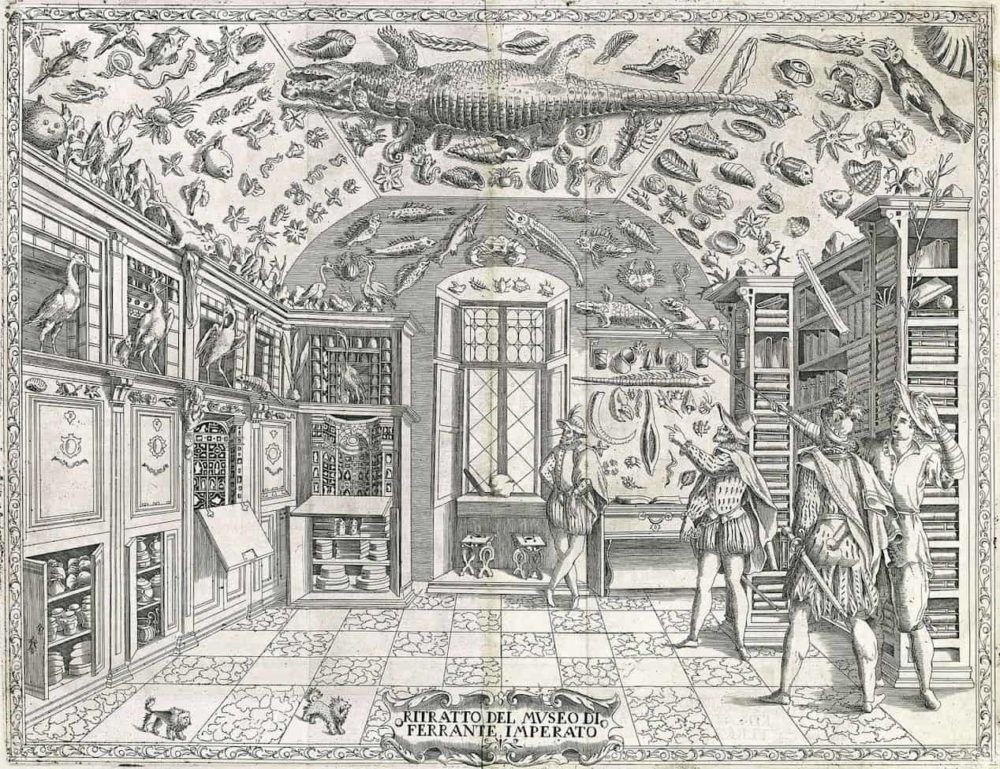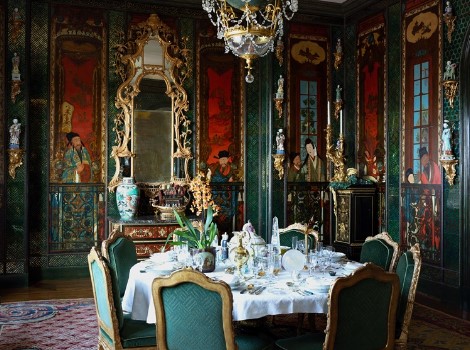Maximalism, as one might guess, is an aesthetic that heavily opposes minimalism. Where minimalism says “Less is more”, maximalism responds with “No, actually, more is more.” Maximalism is a form of expression that relies on excess. Although the word maximalist has only started gaining prominence in the last few decades, the concept has been around for a long time.

Maximalism can be traced all the way back to the 16th century, where it could be seen in cabinets of curiosities. These cabinets of curiosities were personal collections of a variety of items ranging from preserved plants and animals to exotic treasures. The image to the right (Ferrante Imperato, 1599) is one of the earliest recorded examples of maximalism and shows a room the walls and ceilings covered with preserved animals. This was a show of wealth and a way for people to entertain guests.
By the mid-1800’s, maximalism became much more accessible. As mass production ramped up and it became easier to acquire goods, maximalism trickled down from the upper class to the upper middle class which was looking for a way to display their disposable income. This Victorian version of maximalism started with several framed paintings covering a wall or entire room.
Since the mid 2010’s, maximalism has seen somewhat of a revival. After the recession in the US in the late 2000’s, the popular style shifted towards minimalism. This was a way of saying that less doesn’t actually have to be less. Since the recession, maximalism sprung up as a cultural reaction to minimalism, leading people to spend more money on a variety of interesting items to display within their homes. This led to the resurgence of maximalism and people creating these collections on display in their homes.
Although mainly seen as a decorative aesthetic, maximalism also can be seen in other mediums, such as fashion and art. Maximalist fashion has an extravagant and over the top approach and is heavily dependent on contrast in colors, patterns, shapes, and materials. Major fashion brands such as Gucci have been known to embrace maximalism in their clothing design which can be seen in their signature red and green colors and patterned fabrics. The maximalist art movement is an often overlooked aesthetic in art that came as a direct reaction to minimalism. It often features bright colors and several points of focus. Similarly to maximalist fashion, the art focuses on distinct colors, patterns, and shapes that exist together to create some sort of form.
Sources:
“Maximalism.” Aesthetics Wiki, https://aesthetics.fandom.com/wiki/Maximalism.
Jennings, Rebecca. “The New Maximalism.” Vox, 14 Oct. 2020, https://www.vox.com/the-highlight/21506030/maximalism-minimalism-home-design-jungalow.
Sotheby’s Institute of Art. “Cabinets of Curiosities and the Origin of Collecting.” Sotheby’s Institute of Art, https://www.sothebysinstitute.com/news-and-events/news/cabinets-of-curiosities-and-the-origin-of-collecting.
Mark Cocksedge 2021, A room designed by House of Hackney in Trematon Castle, accessed 30 Jan 2023 <https://www.vogue.com/article/what-does-it-mean-to-be-maximalist-interior-designers-explain>
Plamen Petkov 2017, Kaleidoscopic Spaghetti room in TOILETPAPER Paradise, accessed 30 Jan 2023 <https://aninteriormag.com/maximalism-design-movement/>
Luigi Premazzi 1848, Grande salotto del Palazzo Mikhailovsky, San Pietroburgo (ora il Museo Russo), accessed 31 Jan 2023 <https://www.messynessychic.com/2021/04/07/a-brief-compendium-of-historical-maximalism/>
Emre Can 2019, Interior with Brass Chandelier, accessed 31 Jan 2023 <https://www.worthwhile-magazine.com/articles/a-maximalist-at-heart-confessions-of-a-millennial>
Visko Hatfield 2022, Ann and Gordon Getty’s San Francisco Residence, accessed 31 Jan 2023 <https://www.christies.com/features/maximalism-collecting-guide-12398-3.aspx>
Jessie Prince 2017, Maximalist Home Design, accessed 31 Jan 2023, <https://www.apartmenttherapy.com/the-simple-key-to-keeping-a-maximalist-house-tidy-248828>


4 Comments. Leave new
I personally find myself connecting more with minimalism, so I picked out your blog because I wanted to understand an aesthetic completely opposite of that, as you mentioned. I liked how you included the history of maximalism and thought it was really interesting how displays of wealth played a large factor in this aesthetic. I think a lot of criticism of brands like Gucci are that a lot of it is about displaying wealth and it’s fascinating how the aesthetic you chose had this common theme from several hundred years ago as well as today. Do brands like Gucci explicitly state they are going for the maximalism style or was that your interpretation after your research (seems like a valid perspective)?
Thanks, Holly. Although I haven’t seen anywhere where Gucci explicitly states their maximalist aesthetic, it is rather widely accepted that this is the truth. By looking at the history of Gucci designs, you can see that they have fully embraced maximalism as the face of the brand.
The subject of maximalism was incredibly interesting, specifically its origins. Displays of wealth have long been made throughout human history, though the fact that an aesthetic arose from such displays is fascinating. I had no idea that the style of both fashion and decor was developed so far back. The impacts that the recession of 2008 had on this aesthetic is incredibly interesting too, as it shows how intertwined our world really is. In the post, you stated that maximalism was making a comeback, and provided examples within fashion. Are there any new innovations or revitalizations within decor today?
It really is quite interesting how the economy can have an impact on aesthetics. And to answer your question, there are always new things being done in decor. As someone with limited knowledge about the interior design and decor scene today, all I can say is that maximalism is a big trend right now, but I don’t have enough information to speak on anything else.